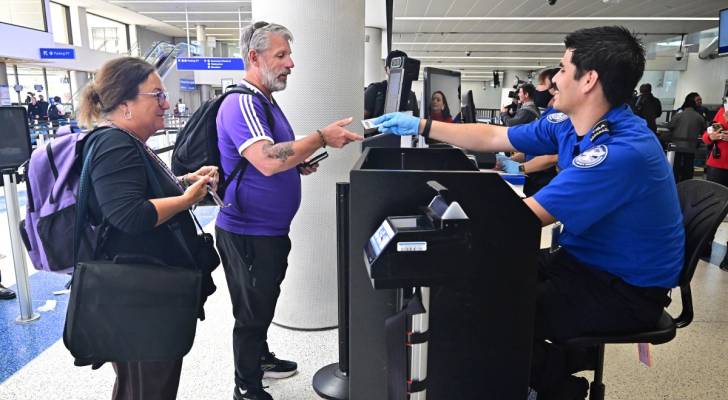Travellers hand their travel documents to a TSA officer at Los Angeles International Airport (Credit: AFP)
Travel to US drops 11.4% amid deportation fears
The US is witnessing a significant drop in international visitors, as political concerns, immigration fears, and economic factors dampen the appeal of traveling to the country, according to newly released government and industry data.
Figures from the US National Travel and Tourism Office reveal that in March 2025, international arrivals fell by 11.4 percent compared to March 2024, totaling 2.4 million visitors. While travel fluctuated throughout the year, the March numbers offered the clearest picture yet of an ongoing slump in tourism.
Widespread declines across regions
Western Europe saw a notable 17.2 percent decline in arrivals, with Germany and the UK—two of the top 20 countries for US visitors—down 28.2 percent and 14.3 percent, respectively. Both nations had recently updated their travel advisories following incidents of their nationals being detained by U.S. immigration authorities.
South and Central America reported even sharper declines. Colombia’s visitor numbers were down 36.3 percent, Ecuador’s by 25.9 percent, and Venezuela’s by 23.3 percent. In Central America, countries such as El Salvador, Honduras, and Nicaragua saw drops between 36 percent and 42 percent.
Meanwhile, Mexico—a key source of tourism—registered a 23.2 percent decline in total visitors and a 25.1 percent decrease in tourist visas. These countries had all been subject to immigration enforcement and deportation flights under Trump-era policies. Mexico also faced heightened trade tensions, following US threats of tariffs.
Political rhetoric and economic headwinds
In Canada, preliminary data for January and February 2025 showed visitor declines of 8.1 percent and 9.8 percent, respectively. No figures were available yet for March and April. Bilateral relations with Canada worsened after President Donald Trump suggested Canada become the “51st state,” triggering a new round of economic disputes.
The World Travel and Tourism Council (WTTC) echoed these concerns in a report released Thursday, attributing the downturn to “unpopular government policies, fear of being stopped and deported at the border, and a strong US dollar.” Travel from Canada and Mexico—traditionally the two largest inbound markets—was reportedly down 20 percent year over year.
WTTC’s president and CEO Julia Simpson told Reuters that international visitor spending in the US is projected to fall to under USD 169 billion in 2025, down from USD 181 billion in 2024, and still 22 percent below 2019 pre-pandemic levels.
New York hit hard
New York, the most visited state in the US, is particularly impacted. Research from Tourism Economics forecasts a drop in international arrivals from an expected 14.1 million in 2024 to 12.1 million in 2025.
Julie Coker, CEO of New York City Tourism + Conventions, emphasized the economic consequences of this trend. “Although international visitors make up 20 percent of total visitation, they account for approximately 50 percent of all visitor spending, making them essential to New York City’s economy."
“Combined, this downward revision represents an estimated loss of over $4 billion in direct spending,” she added. Coker said the city plans to launch a global tourism campaign featuring the Statue of Liberty, targeting audiences in 17 countries including Canada, Mexico, western Europe, Latin America, the Middle East, and Asia-Pacific.
While most regions saw declines in March, the Middle East and Eastern Europe were rare exceptions, registering slight increases of 17.7 percent and 1.5 percent, respectively. In particular, visitor numbers from "Israel", Cyprus, and Turkey rose by 21.1 percent, 12 percent, and 25.4 percent, respectively.
Early data from April suggested a potential rebound, with an 8 percent increase over March. This bump may be attributed to travel during the Easter holiday season, though officials remain cautious about long-term trends.




